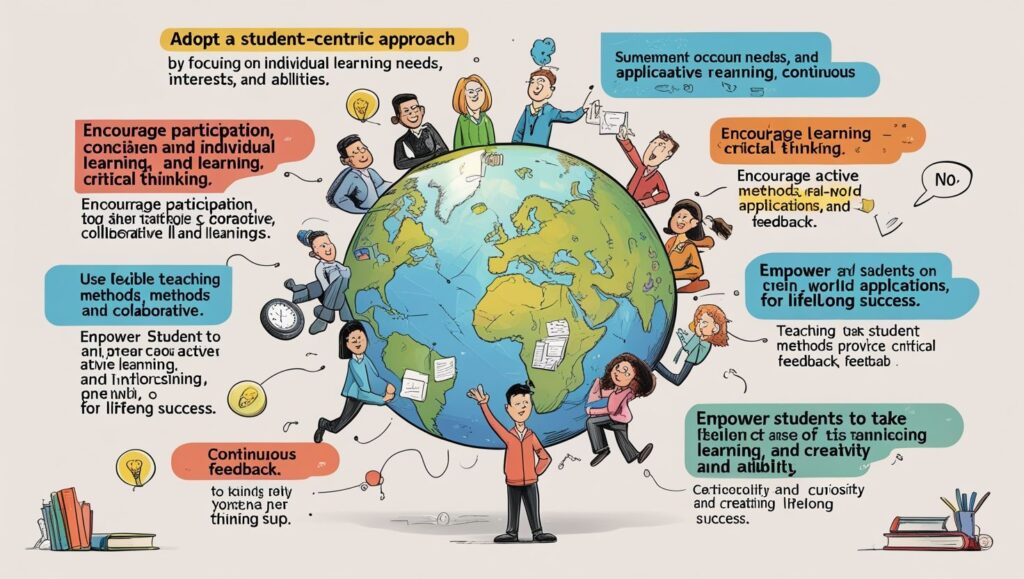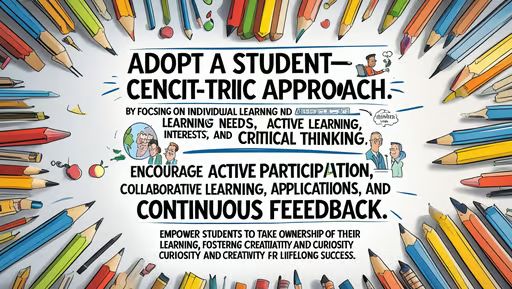Introduction
Student Centric Approach to Teaching has emerged as a fundamental paradigm shift. This methodology places students at the heart of the learning process, tailoring educational experiences to their unique needs, interests, and learning styles. In this comprehensive exploration, we delve into the principles, strategies, and benefits of adopting a student-centric approach, aiming to transform classrooms into dynamic spaces that empower and inspire learners.
I. Understanding the Student-Centric Approach:
At its core, a student-centric approach recognizes that each student is a unique individual with distinct learning preferences, motivations, and abilities. This approach shifts the focus from a one-size-fits-all model to a more personalized and flexible learning environment. It involves educators actively engaging with students, understanding their backgrounds, interests, and aspirations, and incorporating these elements into the teaching process.
II. Personalized Learning Paths:
Central to a student-centric approach is the concept of personalized learning paths. Recognizing that students have different paces and styles of learning, educators must implement strategies such as differentiated instruction, project-based learning, and competency-based assessments. This allows students to progress at their own pace, ensuring a deeper understanding of concepts and fostering a sense of autonomy and responsibility for their education.
III. Inclusive Education :
An inclusive approach is a cornerstone of student-centric teaching. Recognizing and accommodating diverse learning needs, including those of students with varying abilities, backgrounds, and learning styles, ensures that every student feels valued and supported. Creating a classroom culture that celebrates diversity and promotes inclusivity enhances the overall learning experience and prepares students for a globalized world.

IV. Active Student Engagement :
Fostering active student engagement is pivotal in a student-centric classroom. Encouraging discussions, collaborative projects, and hands-on activities not only enhances understanding but also cultivates critical thinking, problem-solving skills, and effective communication. Creating an environment where students are active participants in their learning journey fosters a sense of ownership and enthusiasm for education.
V. Continuous Feedback and Assessment :
A student-centric approach emphasizes ongoing feedback and assessment as opposed to traditional summative evaluations. Regular formative assessments, peer evaluations, and self-assessment enable students to track their progress, identify areas for improvement, and take ownership of their learning. This continuous feedback loop not only informs instructional decisions but also promotes a growth mindset among students.
VI. Technology Integration: .
Leveraging technology is integral to a student-centric approach. Educational tools, online resources, and digital platforms can enhance learning experiences, providing opportunities for interactive and self-directed learning. Integrating technology also prepares students for the digital age, equipping them with essential skills for the future.
VII. Cultivating Critical Thinking and Creativity :
A student-centric approach goes beyond rote memorization, emphasizing the development of critical thinking and creativity. Encouraging students to ask questions, solve real-world problems, and think independently fosters a deeper understanding of concepts and prepares them for a rapidly evolving world where adaptability and creativity are essential.
VIII. Teacher as Facilitator and Mentor:
In a student-centric classroom, the role of the teacher evolves into that of a facilitator and mentor. Teachers guide and support students, creating a learning environment that encourages exploration, inquiry, and collaboration. This shift in the teacher’s role promotes a more student-driven and participatory educational experience.
Conclusion:
In conclusion, embracing a student-centric approach is a transformative step towards creating a dynamic and effective learning environment. By recognizing the individuality of each student, personalizing learning paths, fostering inclusivity, promoting active engagement, providing continuous feedback. Integrating technology, and cultivating critical thinking, educators can empower students to become lifelong learners. This approach not only enhances academic outcomes but also nurtures the holistic development of students. Preparing them for success in the complex and ever-changing world ahead.

Your point of view caught my eye and was very interesting. Thanks. I have a question for you.
Thank you for your sharing. I am worried that I lack creative ideas. It is your article that makes me full of hope. Thank you. But, I have a question, can you help me?
Can you be more specific about the content of your article? After reading it, I still have some doubts. Hope you can help me.
ag4b0k
mqeck3
With havin so much content and articles do you ever run into any issues of plagorism or copyright infringement? My site has a lot of exclusive content I’ve either authored myself or outsourced but it seems a lot of it is popping it up all over the internet without my authorization. Do you know any ways to help prevent content from being stolen? I’d truly appreciate it.
wymvi1
00dqzk
Новичкам в мире онлайн-торговли — начни с этих важных пунктов
1. Конкуренция и демпинг
Одной из главных проблем для продавцов на маркетплейсах является переизбыток предложений.
Небольшие магазины часто теряют позиции из-за необоснованного снижения цен.
2. Высокая комиссия площадки
Торговые сервисы часто берут существенные проценты, что влияет на рентабельность.
Это заметно при низком среднем чеке.
3. Сложности с логистикой
Сроки и стоимость доставки — ещё один фактор риска.
Некоторые маркетплейсы накладывают свои правила доставки, что снижает гибкость.
4. Проблемы с отзывами и рейтингами
Мнение покупателей сильно формируют доверие.
Но предвзятые клиенты могут создавать ложный имидж.
5. Трудности с модерацией товаров
Фильтрация контента часто приводит к потерям.
Иногда вводятся новые правила, что создает напряжение.
6. Финансовые задержки
Выплаты продавцам — становятся узким местом.
Некоторые маркетплейсы удерживают деньги до 30 дней.
7. Сложности в техподдержке
Техническая поддержка часто переводит между отделами.
Это усложняет решение вопросов.
8. Постоянные изменения правил
Регламенты могут быть запутанными.
Это вносит хаос.
9. Кража контента и идей
Фото могут быть позаимствованы другими продавцами.
Маркетплейсы не защищают авторство, и продавец теряет преимущества.
10. Ограниченный контроль над брендом
Упаковка на маркетплейсах не всегда настраиваем.
Это делает бренд «обезличенным».
slots-for-money-casino.ru
Топ слотов 2025: Где сорвать куш в онлайн-казино? Высокий RTP, захватывающие бонусы, инновационный геймплей и джекпоты! Обзор самых щедрых и популярных игр. Узнайте, какие слоты принесут вам удачу и помогут выиграть реальные деньги! Читайте подробнее:
slots-for-money-casino.ru
slotzal-casino.ru
Привет, друзья! ??
Хотите узнать, как играть в слотзал Casino прямо с телефона? Перейдите по ссылке ниже и получите пошаговую инструкцию! Удобно, быстро и всегда под рукой. Удачи в игре! ??
slotzal-casino.ru
slots-for-money-casino.ru
Топ слотов 2025: Где сорвать куш в онлайн-казино? Высокий RTP, захватывающие бонусы, инновационный геймплей и джекпоты! Обзор самых щедрых и популярных игр. Узнайте, какие слоты принесут вам удачу и помогут выиграть реальные деньги! Читайте подробнее:
slots-for-money-casino.ru
В ЭТОЙ СТАТЬЕ СОБРАНЫ АКТУАЛЬНЫЕ ССЫЛКИ И ПЕРЕХОДЫ НА ПЛОЩАДКУ КРАКЕН ЧЕРЕЗ ТОР/VPN НА АПРЕЛЬ-МАЙ 2025
СПИСОК ВСЕХ ДОСТУПНЫХ ССЫЛОК ДЛЯ ВХОДА НА KRAKЕN ЗДЕСЬ:
https://pleasewait.icu/
Рекомендации по быстрому и безопасному заходу на сайт КРАКЕН:
1. Через ТOR браузер по онион ссылке
а. Скачайте TOR браузер
Для доступа к даркнет-ресурсам, включая Кракен, вам потребуется специальный браузер, поддерживающий Onion-сайты. Самым популярным выбором является Tor браузер. Вот как его установить:
Перейдите на oфициальный сайт Tor проекта.
Скачайте установочный файл для вашей операционной системы.
Установите браузер, следуя инструкциям на экране.
б. Запустите Tor браузер
в. Перейдите используйте актуальную ссылку для доступа к сайту Кракен: Вставьте эту ссылку в адресную строку Tor браузера и нажмите Enter. Это перенаправит вас на главную страницу маркетплейса.
г. Создайте учетную запись
Если у вас еще нет аккаунта на Кракене, вам нужно будет зарегистрироваться. Процесс регистрации включает следующие шаги:
На главной странице Кракена найдите кнопку “Регистрация” и нажмите на нее.
Заполните форму регистрации, указав необходимую информацию, такую как логин, пароль и адрес электронной почты.
Используйте надежный пароль и включите двухфакторную аутентификацию для дополнительной безопасности.
2. С использованием VPN
а. Скачайте и установите VPN
б. Перейдите по ссылке
в. Создайте учетную запись
Если у вас еще нет аккаунта на Кракене, вам нужно будет зарегистрироваться. Процесс регистрации включает следующие шаги:
На главной странице Кракена найдите кнопку “Регистрация” и нажмите на нее.
Заполните форму регистрации, указав необходимую информацию, такую как логин, пароль и адрес электронной почты.
Используйте надежный пароль и включите двухфакторную аутентификацию для дополнительной безопасности.
После регистрации войдите в свой личный кабинет. Убедитесь, что вы используете актуальные ссылки для доступа к Кракену.
Почему выбираю именно Kraken
Сотни других платформ, тысячи товаров, но для меня больше, чем просто магазин. Это место, где покупки превращаются в увлекательное путешествие.
1 Мир безграничного выбора
Здесь собраны товары, которые удивляют: электроника, стильные аксессуары, надёжные инструменты и даже редчайшие коллекционные предметы. Каждая вещь здесь — это возможность рассказать новую главу вашей истории.
2 Экономия с удовольствием
Скидки и акции здесь — это не просто цифры, а реальные возможности. Я уже успел сделать покупки с огромной выгодой, и уверяю вас: это приятно не только для кошелька, но и для души.
3 Безопасность и забота
Знает, как важно быть уверенным в каждой покупке. Полная защита сделок и дружелюбная поддержка создают чувство, будто вы находитесь в заботливых руках. Надёжность? Абсолютно.
Почему именно
Потому что здесь всё про вас: ваш стиль, ваш комфорт, ваша выгода. Попробуйте, и вы поймёте, почему так много людей выбирают именно эту платформу!
slotozal-casino-rus.ru
Привет, друзья! ??
Если вы хотите узнать, как играть в слотзал казино через телефон, перейдите по ссылке ниже. Там вы найдете пошаговую инструкцию, советы и полезные рекомендации, чтобы ваш игровой опыт был максимально комфортным и увлекательным.
slotozal-casino-rus.ru
slots-casino-com.ru
Здравствуйте, уважаемые участники форума! ??
Если вас интересует, как играть в Slot Casino Com через телефон, перейдите по ссылке ниже. Там вы найдете подробную инструкцию, которая поможет вам быстро и легко освоить игру. Удачи и приятного времяпрепровождения! ??
slots-casino-com.ru
I will immediately grab your rss as I can’t find your e-mail subscription link or e-newsletter service. Do you have any? Kindly let me know in order that I could subscribe. Thanks.
Thanks for sharing. I read many of your blog posts, cool, your blog is very good.
I am not sure where you are getting your information, but great topic. I needs to spend some time learning much more or understanding more. Thanks for magnificent info I was looking for this information for my mission.
Thank you for your sharing. I am worried that I lack creative ideas. It is your article that makes me full of hope. Thank you. But, I have a question, can you help me?
I got what you mean , thanks for putting up.Woh I am thankful to find this website through google.
Your point of view caught my eye and was very interesting. Thanks. I have a question for you.
Thank you for your sharing. I am worried that I lack creative ideas. It is your article that makes me full of hope. Thank you. But, I have a question, can you help me?
I like the helpful info you provide in your articles. I’ll bookmark your blog and check again here regularly. I’m quite certain I will learn plenty of new stuff right here! Best of luck for the next!
I’m still learning from you, as I’m improving myself. I definitely liked reading all that is posted on your blog.Keep the stories coming. I loved it!
Excellent overview